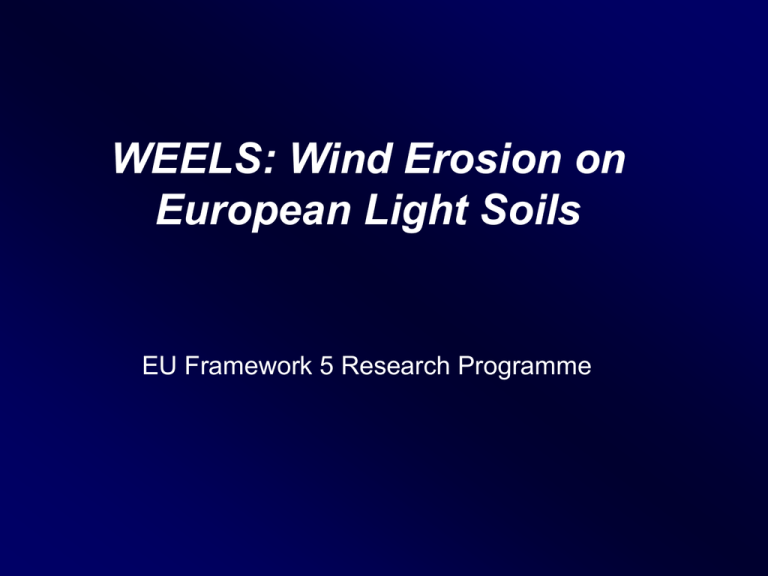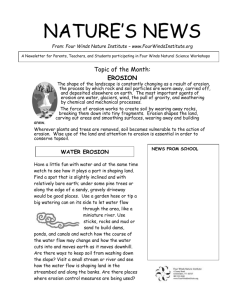Goettingen-WEELS - University College London
advertisement

WEELS: Wind Erosion on European Light Soils EU Framework 5 Research Programme Partners: University College London (co-ordination): Andrew Warren, Dave Gasca-Tucker and others - subcontract to Salford University: Adrian Chappell Soil Survey of Lower Saxony: Walther Schäfer, Jens Groß, Annette Thiermann, Jan Sbresny - subcontract to Göttingen University (research group geosystem-analysis): Jürgen Böhner, Olaf Conrad, Andre Ringeler, Anke Wehmeyer and others Wageningen University: Jan de Graaf, Wim Spaan, Dirk Goossens, Michel Riksen, Olga Vigiak and Floor Brouwer Lund University: Lars Bärring, Marie Ekström and others Three Field Sites (“Supersites”) : All on glacial outwash sands, with similar mean annual rainfall; more snow and frost in the east Main Elements:: • The WEELS model, running with data on wind, temperature, rainfall, soil erodibility and land use • Validation: (a) against a few “event records” in Grönheim and Barnham (b) against estimates of erosion based on the use of 137Cs, for Barnham only • Development of a risk-assessment system, for use where there are fewer data, for Grönheim • Sand and dust monitoring • Climate change scenarios • Economic and policy analysis The WEELS Model:: Jürgen Böhner, Walther Schäfer, Olaf Conrad, Jens Groß and Andre Ringeler Choices: Wind-Erosion Equation (WEQ) Revised Wind Erosion Equation (RWEQ) Wind Erosion Prediction System (WEPS) The WEELS Model - developed from EROKLI (Beinhauer and Kruse, 1994) Components of the WEELS Model (1) WIND: WAsP (Wind Atlas Analysis and Application Program) used to convert hourly wind observations at a meteorological station to values across the supersite according to variation in topography and roughness. WIND EROSIVITY: Several elements, mainly shear velocity U* and mass transport SOIL MOISTURE: The water content of the top 2 cm of soil layer, calculated with a simple model using standard meteorological data Components of the WEELS Model (2) SOIL ERODIBILITY: Essentially, the dimensionless soil erodibility factor‚ ‘K’, depending on aggregate structure and derived from wind tunnel studies, and regressions against soil factors, such as texture and organic matter content. SURFACE ROUGHNESS: soil roughness: aggregate size and tillage (from empirical data, with big assumptions) vegetation roughness: crop type and crop phenology Components of the WEELS Model (3) Michel Riksen, David Gasca-Tucker, Olaf Conrad and others LAND USE: Forage crops: Alfalfa, lucerne Oil seed rape Potatoes, parsnips Set A Side Spring cereals, Linseed Sugar beet, carrots, onions Winter barley, rye, triticale, Winter wheat Maize, sunflower Sugar beet with cover crop Coverage for 1985 (no data brown) Data + simulation for 1985 Windbreak Modelling Olga Vigiak and Annette Thiermann Wind Speed Reduction by Windbreaks 1.0 0.9 Reduction [Ux/U0] 0.8 Optical Porosity 80% 0.7 0.6 Optical Porosity 20% 0.5 0.4 0.3 0.2 0.1 0.0 1 2 3 4 5 6 7 8 9 10 11 12 13 14 15 16 17 18 19 20 21 22 23 24 25 26 27 28 29 30 Distance in Barrier Heights [h] Reduction of Friction Velocities Output: • Hourly assessment of mean wind speed (10 m above ground) and friction velocity • Daily assessments of crop cover, tillage roughness and top soil moisture • Hourly duration of erosive conditions • Maximum sediment transport rate, calculated with and without top-soil moisture • A simplified daily erosion/accumulation balance. Events: • Events recorded during field monitoring: about two at the monitoring site • Events recorded by farmers: mostly rather inaccurate, but one very well recorded event on video: see later 137Caesium Analysis Adrian Chappell • Direct measurement is difficult mainly because it is very episodic (as we found) • 137Cs is an artificial isotope created in nuclear reactions, as in bombs and nuclear power stations (cf Chernobyl) • Output to the atmosphere reached a peak in the mid 1960s, so that one is measuring net erosion over about 35 years • It is now widely used to measure erosion. It is simple, but time-consuming to measure 137Caesium Sampling 137Caesium Theory 137Caesium Profiles, Barnham 137 0 500 1000 Cs 1500 (Bq m-22000 ) 2500 0 10 Depth (cm) 20 30 40 50 Pasture 60 Field Boundary Field 70 Forest 80 3000 Sampling Pattern Semi-variogram 500000 400000 Semi-variance of 137 -2 Cs (Bq m ) 600000 300000 200000 caesium-137 Model 100000 0 0 100 200 300 400 500 Lag (m) 600 700 800 900 Caesium Mass-Balance Model • An existing model (Owens 1994) was modified to include the major factors controlling wind erosion: Land cover and phenology (including plough events) Rainfall to estimate daily 137Cs fallout Wind speed and a fuzzy threshold (5-7 m s-1) for erosion • Erosion and deposition models are for each field and each day Sediment Transport Sampling Dirk Goossens and Jens Groß • Testing sediment samplers (the now widely used MWAC sampler found to be best by many criteria • Very detailed recording of one of the few events on 18 May 1999 Example (a) mean wind direction sand transport (g/cm) > 200 50-200 40-50 35-40 0 50 metres 100 30-35 25-30 20-25 15-20 10-15 5-10 <5 0 25.01.00 - 08.02.00 12.01.00 - 25.01.00 29.12.99 - 12.01.00 16.12.99 - 29.12.99 02.12.99 - 16.12.99 16.11.99 - 02.12.99 04.11.99 - 16.11.99 21.10.99 - 04.11.99 05.10.99 - 21.10.99 21.09.99 - 05.10.99 07.09.99 - 21.09.99 24.08.99 - 07.09.99 12.08.99 - 24.08.99 27.07.99 - 12.08.99 14.07.99 - 27.07.99 01.07.99 - 14.07.99 16.06.99 - 01.07.99 02.06.99 - 16.06.99 19.05.99 - 02.06.99 04.05.99 - 19.05.99 21.04.99 - 04.05.99 08.04.99 - 21.04.99 13.03.99 - 08.04.99 02.03.99 - 13.03.99 16.02.99 - 02.03.99 02.02.99 - 16.02.99 19.01.99 - 02.02.99 05.01.99 - 19.01.99 22.12.98 - 05.01.99 03.12.98 - 22.12.98 16.11.98 - 03.12.98 04.11.98 - 16.11.98 -2 -1 dust accumulation (g m day ) Example (b) 0.5 total dust 0.4 0.3 0.2 0.1 Wind Erosion and Climate Change Lars Bärring, Marie Ekström and others Economics Michel Riksen, Jan de Graaf, and Floor Brouwer For Example: Benefits in €/ha Productio On-site n costs1) costs due to wind erosion2) Without case: sugar beet With case: sugar beet with cover crop With case: sugar beet with plough and press With case: sugar beet with Vinamul layer Net benefits of GAP in case off-site costs=0 Net benefits of GAP for offsite costs=10 times on-site costs Net benefits of GAP for offsite costs=20 times on-site costs 586 175 666 50 45 1170 2420 586 98 77 770 1540 800 50 -89 1036 2286 Some Results: Risk Assessment, Grönheim Some Results: Event Modelling, Barnham L H H Circulation Pattern over Europe 13.03.1994 Some Results: Event Modelling - Barnham Erosion/Accumulation Balance (12.03. - 15.03.1994) Wind Speed [10 m a.G.] Honington 18.0 16.0 Wind Speed [m/sec] 14.0 12.0 10.0 8.0 6.0 4.0 2.0 0.0 0 4 8 12 16 20 12.03 0 4 8 12 16 20 13.03 0 4 8 12 16 20 14.03 0 4 8 12 16 20 15.03 Some Results: Longterm Estimation (1970-98) Duration - Barnham 0.14 Erosion Hours 0.12 0.10 0.08 0.06 0.04 0.02 0.00 1 2 3 4 5 6 7 8 9 10 11 12 9 10 11 12 11 12 Transport - Barnham 5.0 Transport Rate [Kg] 4.5 4.0 3.5 3.0 2.5 2.0 1.5 1.0 0.5 0.0 1 2 3 4 5 6 7 8 Erosion/Accumulation Balance - Barnham 0.00 1 Balance [Kg/month] -0.01 -0.01 -0.02 -0.02 -0.03 -0.03 Erosion/Accumulation Balance: -1.5 to 1.8 Kg/m² 2 3 4 5 6 7 8 9 10 Some Results: Cs-derived Estimates Cs-derived estimates: soil flux (Adrian Chappell) Net loss: 0.6 t ha-1 yr-1 279000 Huntswell Plantation and Works Soil flux (g/cm2/yr) Area of erosion deposition 278000 0.35 Northings (m) 0.25 277000 0.15 0.05 276000 -0.05 -0.15 RAF Honington 275000 The King's Forest -0.25 -0.35 Ampton Hall 274000 584000 585000 586000 587000 588000 589000 Eastings (m) Top of scale 0.45 gain; bottom of scale 0.35 erosion (g cm2yr -1) Rate of erosion deposition Model vs Measurements • Crude comparison of the distribution of “measured” as against “modelled” erosion shows similar patterns, with erosion concentrated in the northeast of the site, but • Model estimates: 137Cs Method: - 1.56 t ha-1 yr-1 vs - 0.60 t ha-1 yr-1 Most models overpredict, but • The disparity is even greater if we acknowledge removal on root crops (2.4 t ha-1 per crop).






